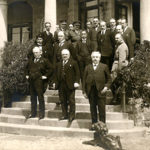Published January 15, 2001
Family Policy, January-February 2001
Many economists, even those who consider themselves conservative Republicans, have tended to look favorably on the movement of mothers out of the home and into the labor market during the last thirty years. The reasons for their position are varied, but at the core they reflect a fundamental clash of worldviews, one that might loosely be described as libertarian and the other as traditional. If all worldviews were equally valid and equally compatible with sound economic analysis, the holding of one worldview over another would make no more difference than one’s preference for juice over soda. But the unkind fact is that not all worldviews correspond equally to reality.
Economists with a libertarian view of society have increasingly resorted to obsolete economic analysis to shore up their philosophical worldview. At the risk of appearing facetious, the combination of libertarian philosophy and antiquated economic analysis—which explains the lack of support for moms-at-home by many economists—might aptly be termed the “stork theory” of economics. Against it stands a time-tested traditional view—which is supported by the best available economic analysis—that can be thought of simply as the “economic facts of life.” These views differ on several issues, to which the answers have important consequences.
The Basic Unit of Society
According to the stork theory of economics, the basic unit of society and of the economy is a curious creature called the individual. All individuals, it seems, are delivered by a large economic stork. Unlike the traditional stork in which children believe, the economic stork only delivers full-grown adults. Though delivery by the economic stork means that individuals do not cost anything to produce, it also implies that affecting the number of individuals in the population is not possible; the population is assumed to be a given factor not influenced by economic policy.
—> The Economic Fact of Life: The basic social unit is the family-based household. This has been obvious since Aristotle stated the reason: The household, not the individual, is the smallest unit capable of reproducing and sustaining itself. In the economy, similarly, the basic units are not the individual worker and the individual employer, but rather the household and (its more specialized modern offshoot) the business firm. Some households do contain individual adults without children, usually before marriage or after a spouses death or separation. But viewed over a lifetime, a man and a woman with children is the norm. Otherwise, no households or individuals would exist. Every adult begins as a baby. The transition from babyhood to adulthood is not a given, but requires a huge investment of resources, mostly by the household.
How Adults Divide Economic Time
According to the economic stork theory, the fundamental economic choice for most adults is between “work” and “leisure.” Under the economic stork theory, individuals therefore fall into two classes: partly useful individuals and totally useless individuals. Partly useful individuals are also known as workers. Workers are only partly useful, because they do not work every single minute of their lives. This is because partly useful individuals always face a choice between work and leisure. Totally useless individuals, also known as mothers, are totally useless because they do not “work” at all. Totally useless individuals devote all their time to leisure: for example, tending household pets called children. By an uncanny coincidence, the population of these household pets tends to swell for about sixteen years before the economic stork delivers more workers. But, stork theorists insist, mere correlation does not mean causality. According to the stork theory, totally useless individuals might as well be their own pet children, since neither contributes anything to Gross Domestic Product and, therefore, nothing of economic use.
—> The Economic Fact of Life: The basic decision facing most adults is not between work and leisure, but whether to work in the market economy or outside the market in the household economy. The household is based on specialization of economic roles. One adult (usually, but not necessarily, the man) specializes in producing services for cash in the market, while the other adult (usually, but not necessarily, the woman) specializes in providing services directly to the household. Even a small difference in earnings potential between the two would make such specialization economically sensible. The rise over the years in the average education level (and thus value of labor market earnings of both men and women), as well as the availability of government transfer payments (an alternative to labor market earnings) have reduced this specialization somewhat; the labor force participation of men has fallen, while the participation of women has risen. However, a high degree of specialization remains, as shown by the fact that most women in the labor force work either part-time or take several years off in their careers to attend to family responsibilities.
In practical terms, this means that few adults spend much time deciding between work and leisure. For most adults, most of the time, the key choice is whether to work in the market economy or to work in the household economy: whether to change the oil in the family car oneself or take it to a shop; whether to do the laundry at home or take it to the cleaners; whether to home-school a child or pay a teacher or tutor. Whether such activity occurs in the household sector or the market sector does not, by itself, affect the economic nature or economic value of the activity in the slightest. But it does make a difference to the measured Gross Domestic Product, since GDP largely ignores such nonmarket activity. This merely proves what good economists have known for a long time: GDP is a poor measure of total economic activity.1 Sound economic analysis, therefore, gives no support for the economic stork theory’s “cult of GDP.”
Factors that Determine Economic Growth
According to the stork theory, the economic stork not only delivers individuals but also technology. Technology is what allows workers to produce more with a given stock of capital (say, to do more work with this year’s computer than last year’s model). Given the assumptions that population and technology are “givens,” what matters most to the economy is “capital,” which the economic stork theory defines essentially as buildings and machines. In this theory, the national standard of living depends basically on increasing something called the capital-to-labor ratio—the average value of buildings and machines per worker. If individuals became more useful—that is, if they worked more hours in the labor market—the economy would be somewhat larger. But unless the supply of capital is increased faster than the number of partly useful individuals (workers), each partly useful individual would be less productive. According to the stork theory, having more partly useful individuals is, therefore, counterproductive because it reduces the capital-to-labor ratio, lowering the country’s standard of living; it would be better if the economic stork did not deliver so many individuals. Imagine the standard of living Americans would enjoy if only one worker (say, Bill Gates) existed instead of 135 million and he owned everything in America. According to the economic stork theory, with that capital-to-labor ratio, the average worker could produce $10 trillion worth of goods a year, instead of only $75,000!
—> The Economic Fact of Life: The economic welfare of American households rests not on one but on three different kinds of assets: people, things, and ideas. Economists call the economically useful parts of people “human capital,” the economically useful parts of things “non-human capital,” and economically useful ideas “technology.” Just as nonhuman capital is the result of investment in things, human capital is the result of investment in people, and technology is the result of investment in ideas. Without prior investment in child rearing or education or training or health or safety or mobility, there would be no workers or skills. Likewise, technological advance is the result of investment in research and development. Just as all property income is the return on investment in nonhuman capital, all labor compensation is the return on investment in human capital, while the return on research and development typically takes such forms as royalties.
Thus the economic facts of life suggest three ways to increase income: investing in people, investing in things, and investing in ideas. Historically, human capital has contributed almost two-thirds of the growth in national income tangible nonhuman capital almost one-third, and research and development about 5 percent. The biggest factor raising income for most families is investment in human capital. As Theodore W. Schultz put it four decades ago, “Laborers have become capitalists not from a diffusion of corporate stocks as folklore would have it, but from the acquisition of knowledge and skill that have economic value.”2
How Public Policy Affects Economic Growth
Since the economic stork theory assumes that the population and technology are both given factors, its advocates argue that the only way to increase incomes is to increase the stock of capital. For any given amount of taxation, they say, this means raising taxes on consumption and cutting taxes on savings. But recall that saving in this theory is defined as investment in buildings and machines. Consumption is defined as everything else: feeding, clothing, and housing all the partly useful and totally useless individuals as well as their totally useless pet children. Any taxes levied on capital must be shifted to workers. That the burden of all taxes should be paid by workers is not only desirable, but also inevitable in the long run, because the number of workers is essentially fixed by the economic stork. The economic point of a “consumption tax,” special treatment of capital gains, and privatizing pay-as-you-go Social Security are all essentially the same; as economist Martin Feldstein explains: “A shift from the current income tax to a consumption tax or a labor income tax.”3 (Feldstein’s statement correctly implies that a consumption tax and a labor income tax are economically equivalent.)
—> The Economic Fact of Life: Increasing the total stock of capital, including human capital, nonhuman capital, and technology, is necessary to increase income. None of these is a “given.” This means that raising taxes on one form of investment more than others will diminish investment in that kind of capital, will cause a general misallocation of resources, and will reduce total investment and economic growth. Apart from reducing the total fiscal burden as far as possible, economic policy should therefore aim at equalizing the tax treatment of all three kinds of assets, not at making them as different as possible. This argues for a broad-based income tax that treats human capital as favor-ably as nonhuman capital and for balancing rather than abolishing pay-as-you-go Social Security. Levying higher tax rates on labor compensation than on property compensation might tend to raise investment in nonhuman capital, but this would be more than offset by a reduction of investment in human capital, which is larger and offers a higher average rate of return. In other words, families faced with the higher tax rates would have to respond by raising fewer children and/or investing less in each child. The resulting misallocation of resources, purely for tax purposes, would necessarily lead to a smaller, not a larger economy.
Despite the facetious label, this description of the economic stork theory is technically correct and identical in substance to the economic arguments contained in countless research papers and speeches churned out by libertarian economists. Instead of saying that the economic stork brings workers and technology, what these papers actually say or presuppose is usually put in phrases like “the labor force is assumed to grow at such-and-such a rate” or “technology is assumed to increase output per hour worked at such-and-such a rate.” The assumption that adults divide their time mostly between work and leisure, not between market and nonmarket activity, is presupposed in such curious but common statements as: “In 1948, relatively few women worked. . . . Now women work in almost the same percentages as men.”4 The presumption that investment in people is not true saving is presupposed in such statements as “personal savings are at a record low.”5
If confronted with the falsity of any of these statements, the respective economist would have to admit that it is technically incorrect in light of the best available economic theory. But somehow the statements are never corrected. The reason: the correction would expose the weakness of the libertarian philosophy that is the main point of the stork theory. Perhaps the most remarkable thing is how seldom other economists point out that such statements are squarely contradicted by the economic facts of life.
NOTES:
1. Theodore W. Schultz, “Investment in Human Capital,” American Economic Review 51 (1961): 1–17; John W. Kendrick, The Formation and Stocks of Total Capital (New York: Columbia University Press for the National Bureau of Economic Research, 1976); and John W. Kendrick, “Total Capital and Economic Growth,” Atlantic Economic Review 69 (1994): 396–410.
2. Schultz, “Investment in Human Capital,” p. 3.
3. Martin Feldstein, “Fiscal Policies, Capital Formation and Capitalism,” National Bureau of Economic Research Working Paper No. 4885, October 1994, p. 14.
4. Bruce R. Bartlett, testimony before the House Committee on Ways and Means, January 28, 1998.
5. Alan Reynolds, “Rich Rewards: Why a Tax Cut Should Go to the Wealthy,” National Review, March 22, 1999.








